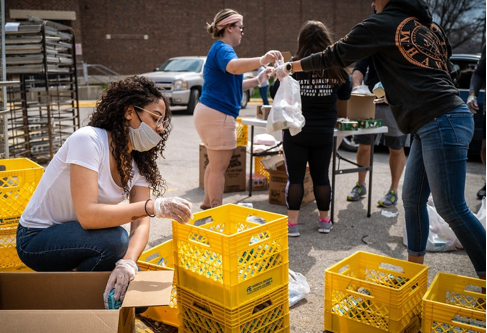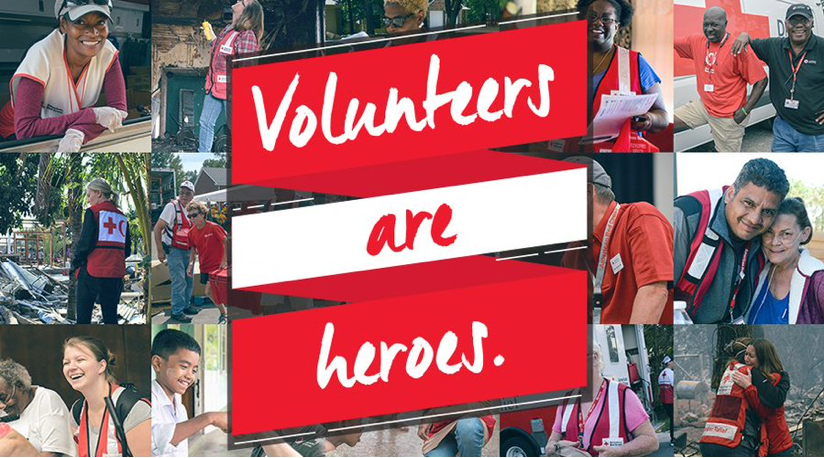5 Volunteers and Voluntary Action
Learning Objectives
After reading this chapter, you should be able to:
- Define volunteering and volunteerism.
- Understand why people volunteer.
- Recognize how organizations use volunteers.
Image: “Green Day’s Tre Cool and ONE Volunteers at Warped” by Brande Jackson is licensed under CC BY-NC-ND 2.0.
5.1 Chapter Introduction
So far in this book, we have covered the theories and the “why” of many issues that nonprofit managers have to consider when running their organizations. We have also discussed how scholars think about nonprofit organizations, their activities and their role in society. This chapter begins to look at how nonprofit organizations organize their resources and work for change, starting with volunteers and voluntary action.
Approximately one third of Americans – almost 80 million people – volunteer every year.[1] Additionally, scholars have estimated nearly 1 million people volunteered internationally every year before the Covid-19 pandemic curtailed international travel.[2] In 2016, the U.S. Bureau of Labor Statistics reported that women are more likely to volunteer than men and the most active age group were those 35-44 years old.
The impact of these volunteers on organizations can’t be under-estimated. Many, if not most, nonprofit organizations rely upon volunteers to support their activities. Smaller organizations may have no paid staff and are completely organized and managed by volunteers. Additionally, almost all nonprofit organizations have a volunteer board of directors providing oversight of the organization. This chapter will first discuss how volunteers are defined, who volunteers and why people volunteer. It will end with a discussion about what managers might want to consider in running a successful volunteer program for their organization.
5.2 Defining volunteering
Believe it or not, there are many different ways to define volunteering. Broadly, volunteering is unsalaried service[3] and is “any activity in which time is given freely to benefit another person, group or cause.”[4] However, while it is undertaken as part of an individual’s leisure time, it is also often considered “work”[5] – making its classification difficult. Most definitions of volunteering include the following four key elements: [6]
- free will.
- no financial reward.
- helping strangers/beneficiaries.
- conducted through an organization.
However, this doesn’t take into account different motivations people have to help and the types of volunteering available. Although volunteering is usually done without a financial reward, individuals can and often do receive a benefit of some sort. For example, they may receive recognition for their service, free t-shirts, free food or free membership with an organization in exchange for their service. In addition, a definition requiring work for a formal organization ignores the fact that much voluntary action is conducted outside of formal organizations.
Informal volunteering is “unpaid, non-compulsory work: that is, time individuals give without pay to activities performed either through an organization or directly for others outside their own household.” Two examples of informal volunteering are driving an elderly neighbor to a doctor’s appointment or watching your neighbors’ children for free if they need a babysitter. Higher rates of informal volunteering – through supporting each others’ communities – are seen among women, people of color and those with lower-incomes. This can lead to negative stereotypes about marginalized communities, creating a belief that they aren’t somehow involved in serving their communities.[7] Most measurements of volunteering in the United States don’t take informal volunteering into account, which can leave many helping behaviors and voluntary actions hidden from view and thus undervalued.

Discussion: Covid-19 and Volunteering
When the Covid-19 pandemic shuttered businesses, churches and nonprofit organizations across the country in early 2020, some individuals stepped up to help their neighbors in need. Read this article about one individual’s effort in the San Francisco Bay Area and discuss the following questions:
- Would you consider Mr. Pham’s efforts in his community formal or informal volunteering? Why or why not?
- What were other strategies taken by others equally concerned about food insecurity during the pandemic?
- How have you and your family or friends engaged in informal volunteering? Formal volunteering?
Image: “Feeding Mind and Body” by Phil Roeder is licensed under CC BY-ND 2.0
5.3 Why Do People Volunteer
While defining volunteering can be challenging, understanding why people volunteer is also difficult, as people volunteer for a diverse set of reasons. They may be motivated by instrumental reasons, like adding to a resume, being social with others, the social environment they live in or a sense of reciprocity they share with their community members, friends and family.
For example, some scholars take a functional approach, suggesting that volunteer motivations serve different functions, or needs, of individuals.[8] These functions may include an interest in expressing their values, learning about the world, personal growth, career development, an interest in social interaction or trying to lessen feelings of guilt or obligation.
Volunteers may be motivated by religious or spiritual obligations or values, a desire to provide community support or life-changing events that may change values and priorities.[9] People may also volunteer for different reasons at different times of their lives.[10]
Both in the United States and internationally, different cultural, ethnic and racial groups may have different reasons for volunteering. Latino/a/x communities, for example, may volunteer for more family-oriented reasons[11], while religion is shown to be an important factor for African-American communities.[12] Informal volunteering is slightly more predominant than formal volunteering in Black and Hispanic/Latino communities[13] but the opposite is true for people with disabilities.[14]
5.4 Valuing Volunteering
Nonprofit scholars and practitioners are also very interested in measuring the economic impact of volunteers. But, how do you measure the value of a volunteer when they are not paid for their services? There are a few different ways practitioners may consider the value of volunteer work within their organization.[15]
One way managers can measure the value of volunteering is to consider the opportunity cost of a volunteer’s time. In other words, what would a volunteer have earned if they were working instead of volunteering their time? While it may be easy to calculate what a volunteer may have earned for the same amount of time in any current employment they have, it is much more difficult to measure the value of the leisure time that individuals are foregoing in order to volunteer.
Managers can also measure the replacement cost of their volunteers. That is, how much would the organization have to pay if they hired someone to do the work a volunteer can do? Although this is more straightforward, there are many volunteer positions – such as donating blood, preparing and delivering meals to the elderly, helping with your church’s yard sale or coaching your kids’ sports team – for which there is no clear market comparison. In addition, how would you replace someone with a paid employee in positions that are almost exclusively held by volunteers – such as board service?
Last, managers can assess organizational value – or the way the organization values their volunteers’ efforts. This is intangible value that may be impossible to place a monetary figure on. Volunteers are ambassadors for the organization, can provide networking opportunities in order to identify collaborative partnerships and may be a key feature of the organization’s values and culture.

Volunteers and the American Red Cross
In Chapter 1 you were introduced to the role of the American Red Cross (ARC) when you were thinking about instrumental vs. expressive organizations. Did you know that 90% of ARC’s workforce are volunteers? Over 300,000 volunteers engage in a variety of activities, from responding to house fires to installing fire alarms to responding to disasters by staffing shelters and providing mental health care, spiritual care and case management. Volunteers also lead local chapters, conduct local fundraising and help to spread awareness about ARC’s activities in their communities. How would you measure the value of these volunteers to the organization?
Image: Twitter https://twitter.com/redcross/status/1251873188515962882
5.5 Considerations for Managers
The challenges facing volunteer managers are complex. How do you match volunteer motivations with the tasks your organization needs? As discussed above, volunteers come to nonprofit organizations for a diverse set of reasons; a successful manager will try to match a volunteer’s interests with positions they need filled in their organization. For example, if you have a volunteer who is looking for something to do in their spare time that offers a social outlet, assigning them to tasks done independently will likely lead to that volunteer not returning to help the organization.
Managers also need to consider what tasks within their organization would best be filled by a volunteer rather than built into the job description of a paid employee. This should be done strategically as part of a larger conversation about staffing needs in organizations.
Lastly, volunteers need to be supported in their roles, or they will lose their motivation and fail to return. Hager and Brudney assert, “unless organizations pay attention to issues of volunteer management, they will not do a good job of recruiting, satisfying, and retaining volunteers.”[16]
To manage volunteers, many leaders use practices and structures recommended by scholars and practitioners that closely resemble other human resource management (HRM) practices used by businesses to hire, train and manage employees.[17] When organized well, volunteering can help meet the social, psychological and professional needs of individuals and help organizations improve their impact. Some questions that managers must consider in launching a volunteer management program are:
- Who will be responsible for managing volunteers?
- What do you need volunteers for? How long do you need them for?
- Where will you find volunteers?
- What training will they require in order to fill their role(s)?
- How will you keep them motivated?

Activity: Develop a Volunteer Management Plan
You are the volunteer manager for the local NAACP chapter that runs a mobile food pantry like this one in partnership with the local food bank, among other programs. Since your organization would like to expand the program to take place in more locations and for more hours every week, your supervisor has asked you to put together a new volunteer plan for the program. Take a few minutes to think about how you would answer the following questions:
- What tasks might you use volunteers for? Who are your ideal volunteers? What are their likely motivations?
- How will you recruit them? (Where will you find them?)
- What type of training will they need to be successful?
- What type of support can your organization provide to keep them motivated and engaged?
- How will you measure their contributions to your mission?
Bonus: Sketch out what a volunteer job description might look like for this role.
Adapted from: Jones, J. A. (2020). “Volunteer management: introducing students to the art and the science.” Management Teaching Review, 5(2), 163-171.
Image: “Cart for the Food Bank” by Waldo Jaquith is licensed under CC BY-SA 2.0
5.6 Summary
In this chapter we discussed the reasons why people might volunteer for organizations, the difference between formal and informal volunteering and some considerations managers may want to integrate into a successful volunteer program. One key lesson is that volunteers are not free to organizations. Working with volunteers in nonprofit organizations requires that managers use volunteers strategically and in ways that will leave both the organization and the volunteer enriched by their service. This takes intentionality and planning to do well. Many organizations may even hire professional staff whose sole job is volunteer recruitment, training and support.
- US Census Bureau, “National Volunteer Week: April 17-23, 2022,” Census.gov, accessed May 4, 2022, https://www.census.gov/newsroom/stories/volunteer-week.html. ↵
- Benjamin J Lough, “A Decade of International Volunteering from the United States, 2004 to 2014,” Research Brief (St. Louis, MO: Center for Social Development, 2015). ↵
- Ram A. Cnaan, Femida Handy, and Margaret Wadsworth, “Defining Who Is a Volunteer: Conceptual and Empirical Considerations,” Nonprofit and Voluntary Sector Quarterly 25, no. 3 (1996): 364–83. ↵
- John Wilson, “Volunteering,” Annual Review of Sociology 26 (2000): 215. ↵
- Lester Salamon, Megan A. Haddock, and S. Wojciech Sokolowski, “Closing the Gap? New Perspecitives on Volunteering North and South,” in Perpsectives on Volunteering: Voices from the South, ed. Jacqueline Butcher and Christopher J Einolf (Switzerland: Springer International Publishing, 2017), 29–52. ↵
- John Wilson, “Volunteerism Research A Review Essay,” Nonprofit and Voluntary Sector Quarterly 41, no. 2 (April 1, 2012): 176–212, https://doi.org/10.1177/0899764011434558. ↵
- Jon Dean, “Informal Volunteering, Inequality, and Illegitimacy,” Nonprofit and Voluntary Sector Quarterly, July 27, 2021, 08997640211034580, https://doi.org/10.1177/08997640211034580. ↵
- E. Gil Clary and Mark Snyder, “The Motivations to Volunteer: Theoretical and Practical Considerations,” Current Directions in Psychological Science 8, no. 5 (October 1, 1999): 156–59. ↵
- James L Perry et al., “What Drives Morally Committed Citizens? A Study of the Antecedents of Public Service Motivation,” Public Administration Review 68, no. 3 (May 1, 2008): 445–58, https://doi.org/10.1111/j.1540-6210.2008.00881.x. ↵
- Takashi Yamashita et al., “Underlying Motivations of Volunteering Across Life Stages: A Study of Volunteers in Nonprofit Organizations in Nevada,” Journal of Applied Gerontology 38, no. 2 (February 1, 2019): 207–31, https://doi.org/10.1177/0733464817701202. ↵
- Beverly B. Hobbs, “Diversifying the Volunteer Base: Latinos and Volunteerism,” Journal of Extension 39, no. 4 (2001): 46–53. ↵
- Ian A. Gutierrez and Jacqueline S. Mattis, “Factors Predicting Volunteer Engagement Among Urban-Residing African American Women,” Journal of Black Studies 45, no. 7 (October 1, 2014): 599–619, https://doi.org/10.1177/0021934714543189. ↵
- Young-joo Lee and Jeffrey L. Brudney, “Participation in Formal and Informal Volunteering: Implications for Volunteer Recruitment,” Nonprofit Management and Leadership 23, no. 2 (2012): 159–80, https://doi.org/10.1002/nml.21060. ↵
- Carrie L. Shandra, “Disability and Social Participation: The Case of Formal and Informal Volunteering,” Social Science Research 68 (November 1, 2017): 195–213, https://doi.org/10.1016/j.ssresearch.2017.02.006. ↵
- Laura Leete, “The Valuation of Volunteer Labor,” in Handbook of Research on Nonprofit Economics and Management, Bruce A. Seaman and Dennis R. Young (Eds.) (Northampton, MA: Edward Elgar Publishing, 2010), 238–48. ↵
- Mark A. Hager and Jeffrey L. Brudney, “Problems Recruiting Volunteers: Nature versus Nurture,” Nonprofit Management and Leadership 22, no. 2 (December 1, 2011): 2, https://doi.org/10.1002/nml.20046. ↵
- Kerstin Alfes, Bethania Antunes, and Amanda D. Shantz, “The Management of Volunteers – What Can Human Resources Do? A Review and Research Agenda,” International Journal of Human Resource Management 28, no. 1 (January 2017): 62–97, https://doi.org/10.1080/09585192.2016.1242508. ↵


